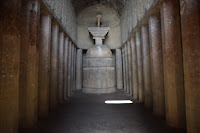Hello
everyone!
 My name is Sharang and through my YouTube channel iroguehermit and my blogs I intend to introduce you
to the places I visit.
My name is Sharang and through my YouTube channel iroguehermit and my blogs I intend to introduce you
to the places I visit.
I
was supposed to explore Rajmachi fort last weekend, however it was too late to
do so and our rider group settled at visiting Godhaneshwar temple at the fort’s
base. The
group I usually ride with is TAG-The Avenger Gods, Pune. We gathered near
Indira College, Wakad and after a brief introduction and exchanging niceties we
headed off to our destination. Our ride began at 7.00 am.
It’s
a highway from Wakad to Lonavala. From Lonavala to Godhaneshwar temple, the
riding distance is around 15-20 kilometers. Beware!
It’s an offroad ride on Kachcha road, filled with boulders, fine reddish soil
and the bikes skid.
 We
reached at the base of Rajmachi fortification and halted a while near Ganapati
Maruti temple for a while, waiting for rest of the riders to join us.We
reached near the temple. Have a look at the nearby hills and you can see the fortification
on the hills.There
is a small pond in front of the temple. Ramrao Naraynrao Deshmukh, the
mamlatdar of Danda Rajpuri got this lake constructed in 1780.
We
reached at the base of Rajmachi fortification and halted a while near Ganapati
Maruti temple for a while, waiting for rest of the riders to join us.We
reached near the temple. Have a look at the nearby hills and you can see the fortification
on the hills.There
is a small pond in front of the temple. Ramrao Naraynrao Deshmukh, the
mamlatdar of Danda Rajpuri got this lake constructed in 1780.
 There’s
a small informative plank near the temple. As visitors, we need to be
responsible towards maintaining the sanctity of this temple. This
Hemadpanthi styled temple was constructed in 8th century during the
reigns of Satavahana. Rocks were cut and placed atop another and this is how it
was built. They say that no mortar was used in the temple’s construction. There’s
a water spout in the shape of Gomukha or cow’s face. It is said that the water
flows from it and fills up the pit below it and from here it flows to the
larger pit and then to the pond.This
is the Shivalaya. I am guessing the rulers patronized Shaivism or worship of
Shiva.The
immediate surrounding is covered with still green vegetation with trees of wild
fruits and berries.You
can spot a statue of Nandi, the vehicle of Shiva at the entrance. It faces the
entrance of the sanctum. There is a constructed pit at its back. Although
the temple is dedicated to Shiva, just outside the sanctum, there are small
idols of other deities as well.
There’s
a small informative plank near the temple. As visitors, we need to be
responsible towards maintaining the sanctity of this temple. This
Hemadpanthi styled temple was constructed in 8th century during the
reigns of Satavahana. Rocks were cut and placed atop another and this is how it
was built. They say that no mortar was used in the temple’s construction. There’s
a water spout in the shape of Gomukha or cow’s face. It is said that the water
flows from it and fills up the pit below it and from here it flows to the
larger pit and then to the pond.This
is the Shivalaya. I am guessing the rulers patronized Shaivism or worship of
Shiva.The
immediate surrounding is covered with still green vegetation with trees of wild
fruits and berries.You
can spot a statue of Nandi, the vehicle of Shiva at the entrance. It faces the
entrance of the sanctum. There is a constructed pit at its back. Although
the temple is dedicated to Shiva, just outside the sanctum, there are small
idols of other deities as well. Before
entering the sanctum, you’ll have to ring the bell. I guess it is customary to
do so. The believers say that ringing the bell creates sounds that helps one be
attentive. It also creates positive vibrations in the atmosphere.
Before
entering the sanctum, you’ll have to ring the bell. I guess it is customary to
do so. The believers say that ringing the bell creates sounds that helps one be
attentive. It also creates positive vibrations in the atmosphere. The
sanctum is a very small room. It has Shivalinga installed inside it and Nagas
made of metal hold their hoods atop the Shivalinga. Water drips onto it from a
small pot hung from the ceiling. After
the worship, it is a custom to take a few rounds around the temple and bring
together both of your palms and perform Namaskar and place your forehead on the
walls of the temple with reverence. I
was fortunate enough to be allowed to enter the sanctum and take a video shoot.
The
sanctum is a very small room. It has Shivalinga installed inside it and Nagas
made of metal hold their hoods atop the Shivalinga. Water drips onto it from a
small pot hung from the ceiling. After
the worship, it is a custom to take a few rounds around the temple and bring
together both of your palms and perform Namaskar and place your forehead on the
walls of the temple with reverence. I
was fortunate enough to be allowed to enter the sanctum and take a video shoot.
Thanks
to the vegetation and the shades of trees around, our offroad journey was eased
a bit. Overall, it was a nice offroad riding experience.
In your comments, do let me know how you feel about visiting this place. Subscribe my YouTube channel i roguehermit, stay updated on tweeter @i_roguehermit, read my blogs on iroguehermit.blogspot.in and follow my Facebook page I Rogue Hermit.
YouTube Video Link - https://youtu.be/DxXe1iBQllM






















